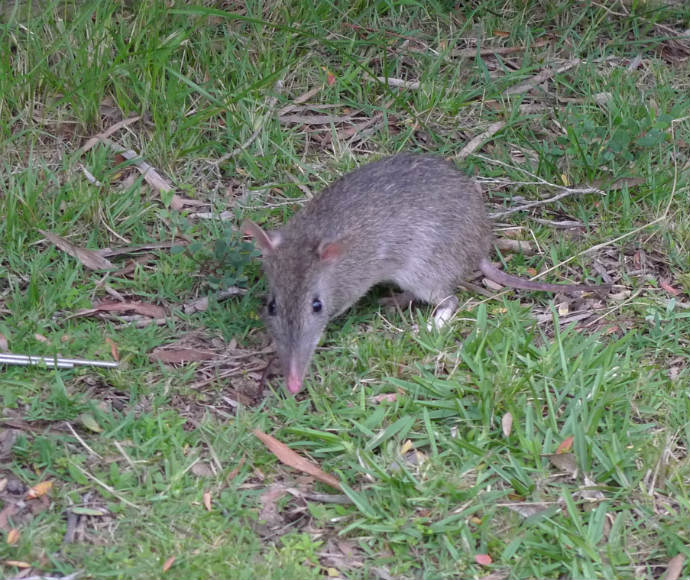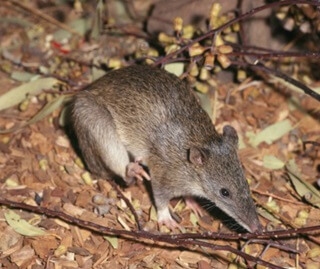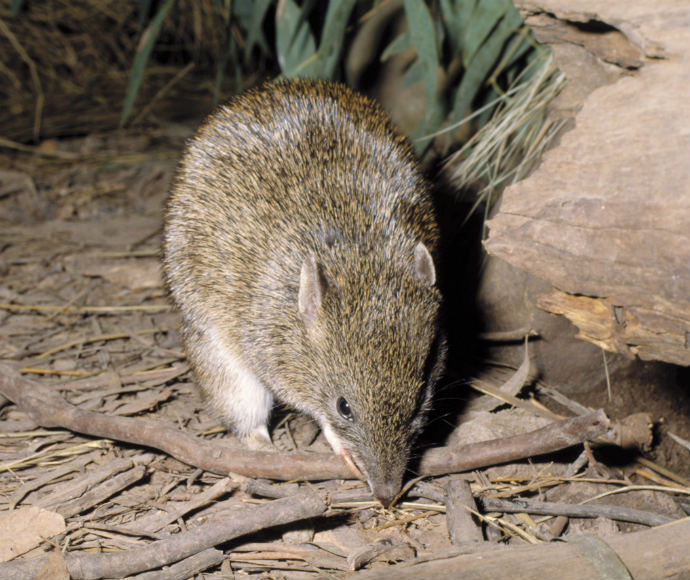Bandicoots are found throughout Australia and can be common in coastal areas of New South Wales. They can live in a wide variety of habitats, from rainforests to wet and dry woodlands to heath. During the day they nest in shallow holes in the ground, lined with leaf litter and built under dense vegetation or debris, hiding them from predators and protecting them from rain and sun.
Bandicoots are about the size of a rabbit and have a pointy snout, humped back, thin tail and large hind feet. There are around 20 species of bandicoots, 3 of which live in New South Wales.
Long-nosed bandicoot
The long-nosed bandicoot (Perameles nasuta) is around 31 cm to 43 cm in size and weighs up to 1.5 kg. It has pointed ears, a short tail, grey-brown fur, a white underbelly and a long snout. Its coat is bristly and rough.
The long-nosed bandicoot is common and widespread throughout New South Wales, particularly in coastal areas and on either side of the Great Dividing Range. This species is the most common species of bandicoot in the Sydney area and is known to visit suburban backyards.

Long-nosed bandicoot (Perameles nasuta)
Northern brown bandicoot
The northern brown bandicoot (Isoodon macrourus) is around 30 cm to 47 cm in size and weighs up to 2.1 kg. It has small, rounded ears, an elongated snout and a speckled, brown-black coat with a pale to white underbelly.
The northern brown bandicoot is common north of the Hawkesbury River, in coastal areas and on the eastern slopes of the Great Dividing Range.

Northern brown bandicoot (Isoodon macrourus)
Southern brown bandicoot
The endangered southern brown bandicoot (Isoodon obesulus) is around 28 cm to 36 cm in size and weighs up to 1.5 kg. It has small, rounded ears, a longish, conical snout, a short, tapered tail and a yellow-brown or dark grey coat with a cream-white underbelly.
The southern brown bandicoot is patchily distributed and occurs south from the Hawkesbury River to the Victorian border and east of the Great Dividing Range.
There are 2 main populations. One lives in Garigal and Ku-ring-gai Chase national parks in northern Sydney. The other lives around Beowa National Park and Nadgee Nature Reserve in the far south-eastern corner of the state. They are smaller and shyer than other species and do not stray far from their preferred shelter of dense heath vegetation.
Visit the endangered southern brown bandicoot profile page to learn more about what is being done to save this species.

Southern brown bandicoot (Isoodon obesulus)
Bandicoot facts
Bandicoots have at least 4 distinct vocalisations:
- a high-pitched, bird-like noise used to locate one another
- when irritated, they will make a 'whuff, whuff' noise
- when feeling threatened or alarmed, they will make a loud 'chuff, chuff' noise and loud whistling squeak at the same time
- when in pain or experiencing fear, they will make a loud shriek.
Bandicoots generally live for 2 to 4 years in the wild. They are territorial and usually solitary. The female stays in a relatively small area to forage and mate, but males have a bigger territory and mark and defend their territory by fighting off other males. They do this by standing on their back legs and clawing at each other's shoulders and backs, often leaving scars.
Bandicoots are multi-oestrus, meaning they breed several times during the year. Females can give birth to as many as 5 babies, but usually only one or 2 survive.
Their gestation period is very short, about 11 days, the shortest of any marsupial. The young are born very tiny and underdeveloped. They travel through a cord attached to their mother's womb to reach the pouch. Here, they drink milk from the mother's teats and grow until they are large enough to leave the pouch. At about 3 months they can begin to live independently.
Bandicoot pouches are open at the back to stop dirt entering the pouch when the mother digs.
Bandicoots, like many of the small- to medium-sized marsupials of Australia, have undergone several species extinctions and significant contractions in distribution since European settlement because of land clearing and the introduction of predators (foxes, dogs and cats). Of the estimated 12 species of bandicoot in Australia, approximately half are now extinct, threatened with extinction or extremely rare.
The relationship between native animals and fire (wildfires and planned hazard reduction burns) is complex and, like all native animals, bandicoots have evolved with fire as a natural part of their environment. Habitat requirements are considered when planning hazard reduction burns, and predator control can be important after fire when bandicoots have less shelter to hide in.
Housing, roads and other forms of urban development have displaced and severely fragmented bandicoot populations, making them vulnerable to the threats of predators and motor vehicles. Road signs displaying a bandicoot pictograph can be seen where roads intersect important bandicoot habitat. The signs alert motorists to drive with care, especially at night when bandicoots are active.
Very few native animals prey on bandicoots. Owls, quolls and dingoes are their only significant natural predators. However, introduced animals such as feral and domestic cats, dogs and foxes pose a significant threat to the future of bandicoots. The NSW National Parks and Wildlife Service (NPWS) manages the threat of introduced foxes to native animals by undertaking control programs specifically aimed at protecting threatened species and endangered populations. Read more about the NSW Fox Threat Abatement Plan.
The long-term viability of the endangered southern brown bandicoot in the wild is made more tenuous by its patchy distribution and there is potential for localised population extinction of this species.
Reporting fox sightings
Foxes remain an active threat to the endangered population of long-nosed bandicoots at North Head. NPWS runs a continuous baiting program in Sydney Harbour National Park to control foxes and better protect the endangered population of long-nosed bandicoots. Further emergency baiting and other predator control activities are implemented as soon as fox presence on the headland is detected. A mortality register of bandicoots killed by foxes or on roads in Manly is also maintained. Members of the community are asked to report any fox sightings and any dead bandicoots in the Manly area, particularly at North Head, to the Harbour North Area (Parks and Wildlife Group) by phoning 02 9960 6266.
Join a bandicoot survey
NPWS closely monitors the southern brown bandicoot to measure its response to fox control and other management actions. All sightings of southern brown bandicoots should be reported to NPWS, noting the location, date, what the bandicoot was doing and any other information which may help. Even dead southern brown bandicoots should be reported and where possible specimens submitted to a museum; bone, hair and DNA samples can all be used by researchers to help inform us about this species. (Remember they can be distinguished from the common species by their small round ears.)
Volunteers are invited to assist NPWS staff with bandicoot monitoring surveys in Garigal and Ku-ring-gai Chase national parks. Email [email protected] to join the volunteer program. This species is so rare that only a few are found each year and there are none in zoos in New South Wales. Seeing or catching one is a unique experience.
Bandicoots and ticks
A wide range of native and introduced animals are hosts for the paralysis tick, which can also afflict humans. Highly mobile animals such as foxes, dogs and domestic and feral cats are particularly susceptible to picking up ticks as they wander long distances through bushland areas and backyards. Ticks increase in response to weather and climatic conditions and where fire has been absent from an ecosystem for a long time.
Bandicoots act as hosts for ticks; their hind feet have a syndactylous (joined) toe, like a comb, evolved for effective grooming and tick removal. However, because they tend to roam over a comparatively small range, often staying within half a hectare of their nests, they don't spread ticks as far as many other animals. Although some people associate bandicoots with ticks, this may be because humans tend to pick up ticks most easily in long grass or thick scrub, which happens to be the type of habitat favoured by bandicoots.
You can help to reduce the spread of ticks in your area by:
- regularly maintaining your garden to control tall grass and weeds, particularly the noxious weed lantana
- spraying yard areas with a malathion-based spray, which lasts for about 2 days. A natural alternative to chemical sprays is a mixture of chilli (cayenne pepper), garlic and vinegar. After being left to brew for a few days, the mixture will discourage most pests if sprayed around the garden. However, remember that any such treatment will also harm beneficial garden invertebrates
- regularly grooming and inspecting pets
- encouraging small, tick-eating birds into gardens.
In May 2014, NSW Health issued a Public Health Unit Alert (PDF 88KB) about a small number of locally acquired human Salmonella Java infections. During the past few years, several young children on Sydney’s northern beaches have been diagnosed with the condition after ingesting sand from public parks and childcare centres. At this stage there have been no other links reported.
Salmonella Java can be caused by accidentally ingesting material containing the bacterium. Long-nosed bandicoot droppings taken from the area at this time tested positive for the bacterium, which is known to transfer from animals to humans.
Experts believe it may be a complicated transfer path and it is still unclear where bandicoots are in the cycle, which is why NSW Health, Taronga Zoo and NPWS are working together to find out more about how the salmonella is being transferred.
Salmonella Java cases have mostly involved young children, as they often put their fingers in their mouths and ingest the bacterium after they have touched a contaminated surface. It is important that parents follow the safety and hygiene advice found on NSW Health website, which includes:
- making sure children wash their hands after playing outside
- discouraging children from putting toys or hands in their mouths while playing outside
- regularly clearing animal droppings from areas where children play
- considering short-term measures by keeping bandicoots out of their backyards.
Once abundant in the backyards of some Sydney suburbs, long-nosed bandicoots have been declining in numbers. Now, the northern beaches from Manly to Palm Beach are one of the last strongholds for long-nosed bandicoots in the Sydney region. There are 2 significant populations: at Pittwater and on the coast near Newport. Because it is cut off from other bandicoot populations by houses, a population of long-nosed bandicoots at North Head in Sydney Harbour National Park at Manly has been listed as endangered and was one of the first endangered population listings in New South Wales.
Similarly, there is an endangered population of long-nosed bandicoots in inner western Sydney, where they live in urban parklands and backyards.
Living with bandicoots
You can contribute to the conservation of bandicoots and other native species by keeping your pets locked up at night and by not allowing your pets to enter national parks at any time.
Deterring bandicoots
Bandicoots are protected in New South Wales, and it is illegal to trap or kill them without a licence. There are several ways you can try to deter them:
- Remove their food source: Bandicoots eat insects, earthworms, insect larvae and spiders, and also feed on plant tubers, roots and truffle-like fungi to supplement their diet. They will move away once the food source is depleted.
- Floodlight the area: Bandicoots dislike light and will avoid well-lit areas.
- Add chicken manure to the lawn: Bandicoots don't like strong ammonia smells.
- Build bandicoot-proof fencing: Use fine galvanised wire mesh, or any other material with gaps no larger than 20 mm. The foot of the mesh should be buried to a depth of at least 150 mm, and the fence should rise at least 500 mm above the ground.
Please note it is suggested that you contact your local council to determine if development consent is required for constructing a fence and that you obtain any necessary approvals before commencing any works. This is especially important in the vicinity of North Head, where residents are encouraged to allow bandicoots to move across the landscape.
Protection of native animals
All native birds, reptiles, amphibians and mammals, but not including dingoes, are protected in New South Wales by the Biodiversity Conservation Act 2016.